The last time we looked at wool embroidery threads, we were comparing four different brands of crewel wool, stitched in lines using stem stitch.
We were able to see their twist, how heavy a line they made, and we talked a bit about the stitching experience with them: which ones were a little more fuzzy, more bouncy, and so forth.
Today, we’ll look at the same four threads, this time in filling stitches, specifically satin stitch and “soft shading” or long and short stitch.
My samples here are quite small, so I’ve enlarged them so that you can see the details of the thread.
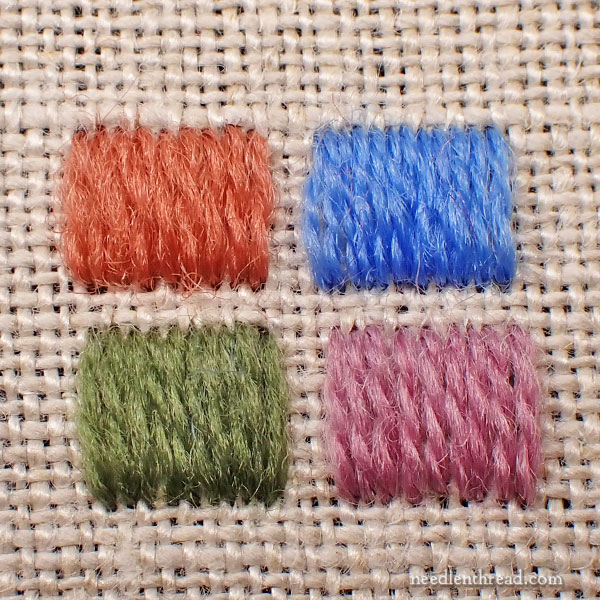
Here, we have all four thread types, each represented by a different color, worked in satin stitch.
Starting at the top left, and reading each row left to right:
Orange – Appletons
Blue – Fine d’Aubusson
Green – Heathway
Pink – Eco Vita
The rectangles are approximately 1/4″ high and 3/8″ wide.
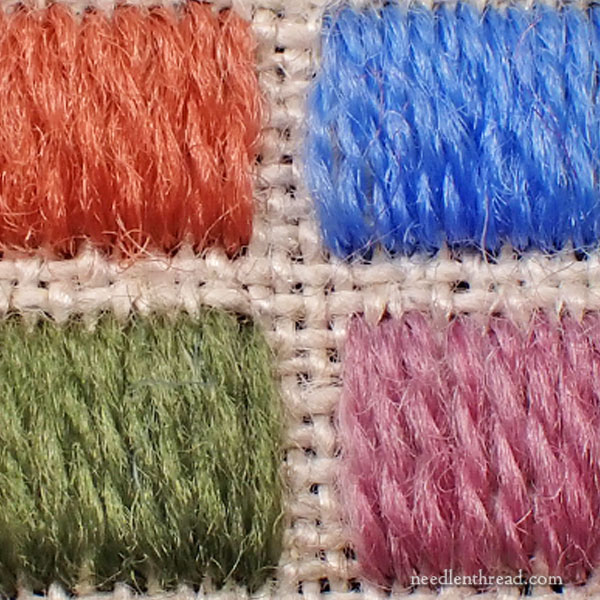
They all look pretty decent in satin stitch.
And you might think they all look pretty much the same in satin stitch, but they don’t.
Appleton (orange) and Eco Vita (pink) are the heaviest of the four threads, so they take fewer stitches to fill the space. They seem to have a bit more “spread” to their wool.
Fine d’Aubusson (blue) is the finest of the four and required the most stitches to fill the space. Of the four, it has the best sheen in the satin stitch.
Heathway has a nice spread but this particular bit of the wool didn’t have as great a sheen as I usually experience with Heathway. It’s also a bit fuzzier than usual. It used just about a couple more stitches to fill the space, compared to Appleton and Eco Vita.
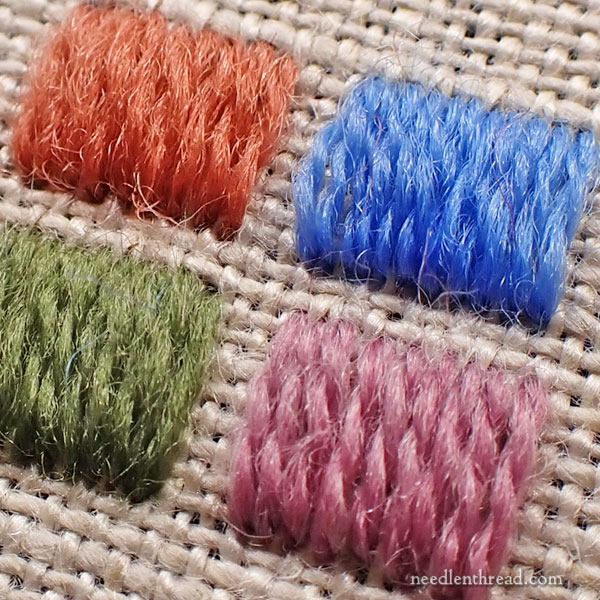
They all held up to the satin stitching quite well, but obviously the space is very small, so it’s not as if the thread had the opportunity to wear out!
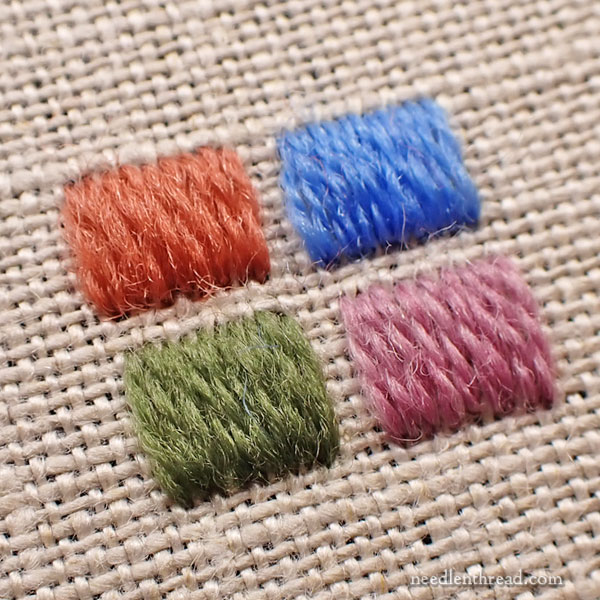
I prefer the look of the Fine d’Aubusson in the satin stitch – I like the sheen and the finer twist. But the Eco Vita and the Appleton were extremely quick to work up, and they both fit the (32) count of this fabric just fine. I used the fabric holes to space the satin stitch, for the most part.
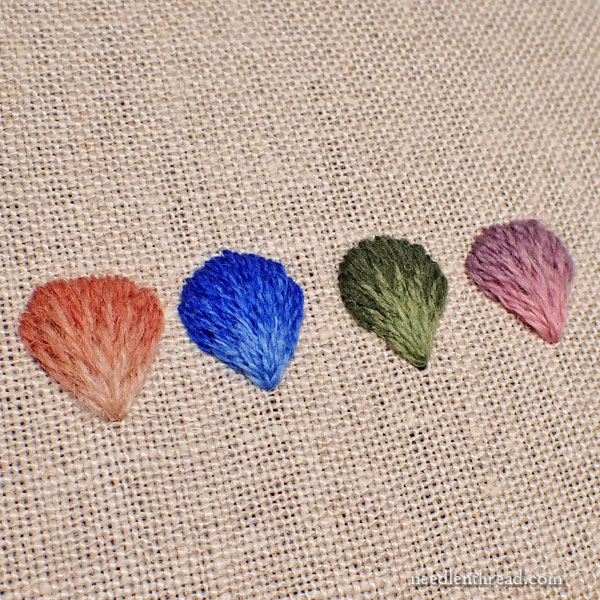
These small petal shapes are about 5/8″ long and 1/2″ wide, so not huge, but they are bigger than the little rectangles.
I used three shades of each brand of thread, all three in the same color family.
With the Heathway (green), I ended up skipping a shade between the three. Each color in Heathway comes in nine shades, numbered 1 – 9. Instead of using 7, 8, and 9, I used 5, 7, and 9. The reason for this was that you couldn’t otherwise tell much of a difference in this small space.
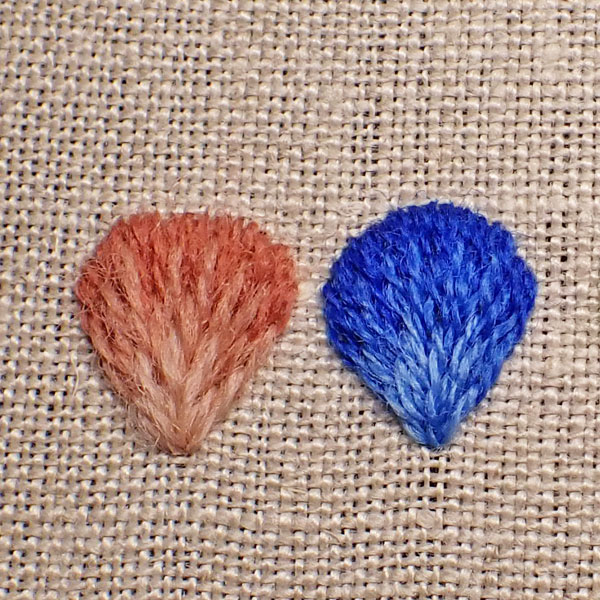
The stitching experience with the soft shading is much different than the stitching experience with satin stitch because the working thread, once you start to add a second and then a third shade, is passing through other stitches, splitting them.
Appleton (orange) resulted in a much more distinct stitch pattern for two reasons: the shades I had on hand were not necessarily (but I don’t know, because I don’t have the whole range) right next to each other in the shade line-up. So the result in shading is not subtle. The other reason is that the thread is somewhat heavier and fuller, so the small space doesn’t tolerate as many stitches.
There’s a definite drag and a bit of a pilling effect on Appleton when working this type of stitch. It wasn’t bad (the space is not big enough for it to be bad), but you can definitely feel it when you stitch with it.
It could be helpful to needle up (increase the size of your needle at least one number) to reduce some of that drag. I’m not sure if you can avoid pilling with Appleton – it helps to give this thread a little “haircut” now and then, when you notice fuzz on the sides of the threads.
The Fine d’Aubusson, with its finer twist and finer weight, shaded much more subtly. The colors I had on hand were, I believe, a sequence of shades in the same color family, which also accounts for a very smooth transition of shades.
I was able to use more stitches to fill the space, which also attributes to the softer effect of the shading. The thread has a nice sheen, which helps the eye blend the shades. The thread passed through the previous stitches very nicely.
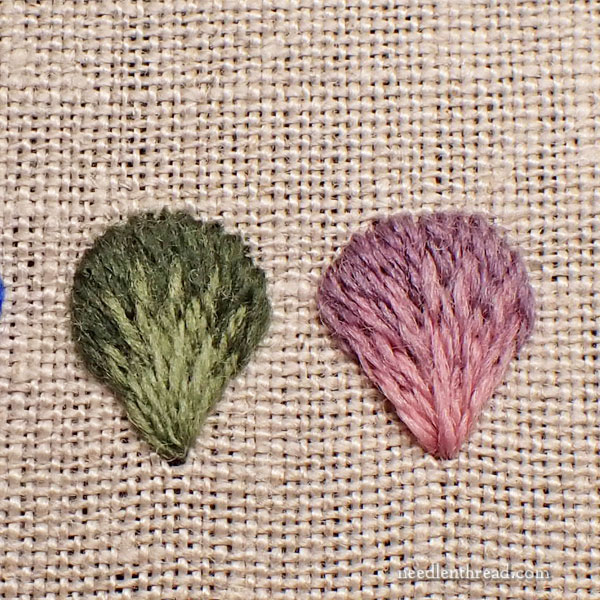
The Heathway (green) worked up easily, with very little drag as it passed through the stitches. It has nice coverage.
The shading is not as subtle on this one because I had to skip threads in the line-up (as mentioned above). I used more stitches to fill the area (similar to the Fine d’Aubusson, but not as quite many stitches).
The Eco Vita (pinkish-purple) worked up like the Appleton, more or less – the shading is not as subtle due to shade options available, but it’s gradual enough to shade small to medium-small areas.
I used fewer stitches than Fine d’Aubusson and Heathway, and fewer, too, than Appleton, because it is a slightly heavier thread. It works up very quickly. There was a bit of noticeable drag on this thread, too, as it passed through previous stitches, but I didn’t experience any pilling. I resolved this by increasing the size of my needle. The result was instantly a smoother stitching experience.
Upshot
I thought all four threads stitched up fine in satin stitch. While I preferred Fine d’Aubusson and Heathway with the shading due to the finer thread weight when stitched, I appreciate the fact that the Eco Vita covers quite nicely, making it a great thread for filling areas efficiently. I’m always disappointed when Appletons pills on me, but hey ho, that’s just how it is.
Want to Try Some Wool?
If you want to try stitching with wool and if you love natural and earthy color palettes, you’ll love the new Eco Vita naturally dyed wool from DMC. I like it! It works great for regular surface embroidery in wool. I’m kitting up this wool bouquet project with it – it looks so pretty on the lovely white linen twill.
Those kits will be released in the not-too-distant future.
I still have a handful of the limited edition half-sets of Eco Vita available here in the shop. It’s a great way to acquire 30 of the choicest colors in the collection. The set is beautiful and it comes beautifully boxed!
We’ll be looking at other wools down the road, but for now, I hope you enjoyed these articles comparing these four types of wool threads for hand embroidery.
If you are just joining in, these links will take you to previous articles comparing these wool threads:
Crewel Threads: A Close Look at Wool Embroidery Threads
Wool Embroidery Threads, Stitched (line stitching with stem stitch)
Have a Wonderful Wednesday!








Thank you for the test and showing the results. I too liked the looks of the Eco Vita. I have not seen it here, so may have to look on line.
I would like to use Eco Vita for embroidering a wool blanket. But how well would it stand up to dry cleaning as the colors are natural dyes? Please advise.
According to DMC, they are colorfast.
Hi Mary,
I’ve tried the Appleton wool and the Fine d’Abusson and like them both. The others are new to me. I love to combine a strand of wool and a strand of cotton floss, DMC or Anchor in the needle to add depth, increase shine for highlight or shadow. It’s also fun to combine with one strand of silk. So fun to play with the combo to change a flower from mauve to rose, or modern to antique by choosing threads carefully.
Hope your vision is improving, praying for you!
Blessings, Sharon
Thank you so much for your comparison series. I now know that I much prefer the Eco Vita to the Appletons.
Appleton Wools from the UK are beautiful and color fast….. The Crewel Work Company has a fabulous YouTube video on blocking your piece to get lumps and wrinkles out….. you will pin it into a bulletin board…. which has been covered with clean plastic…. penning all around the edges with the rust proof t-pins at a 45° angle from the fabric. nice and tight all the way around and then with a clean unused spray bottle you spray it with distilled water. soaking all the linen and getting in between all spaces that the wall surrounds..
It will dry lovely and tight and wrinkle free..
And I know that Appleton walls will not bleed any color onto the linen?…..